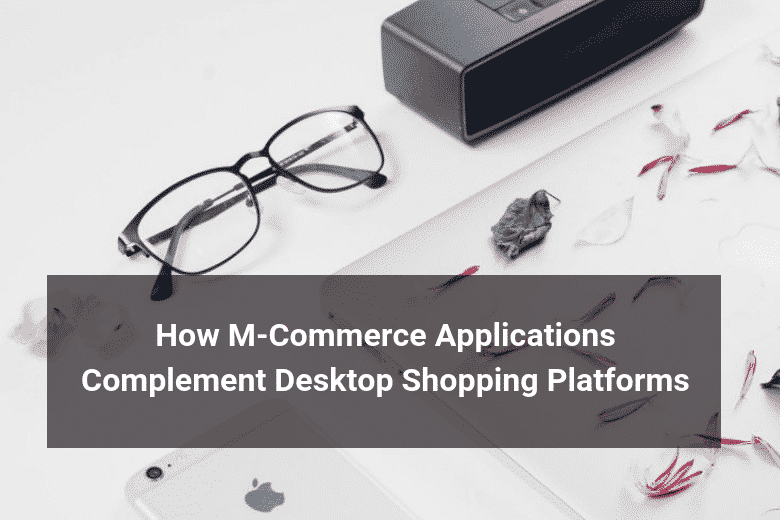Most of the e-commerce owners launch websites as a supplementary means to promote their brand online while still owning a real shop. If e-commerce was initially created to support the businesses, why should one invest time and money into yet another online shopping channel? Besides, desktop versions of shopping websites can be opened with the help of mobile browsers.
You may wonder:
- Why do I need m-commerce when there’s e-commerce?
- Is m-commerce somewhat different from e-commerce?
- How do I improve my mobile sales?
These questions are begging to be answered. M-commerce is an integral part of successful shopping strategies developed by the most prosperous platforms. Such massive pillars of retail as Amazon, Ali-Express, eBay and Groupon all have intelligible m-commerce applications. In fact, mobile apps have driven nearly 40% of sales during the 2018 holiday season.
M-Commerce vs E-Commerce
M-commerce, that is mobile-commerce, simply means the buying and selling of goods and services through wireless handheld devices such as mobile phones and personal digital assistants (PDAs). M-commerce is all about the art of buying and selling through portable mobile devices.

The term can be considered a sub-part of e-commerce (electronic commerce) since e-commerce term is used for shopping performed through any electronic device, including smartphones. However, in this article we are referring to e-commerce platforms as immobile, desktop platforms launched for computer use.
The major differences between m-commerce and e-commerce worth mentioning are as follows:
- M-commerce features transactions made via portable devices such as iphones, iPads, tablets, while e-commerce requires computers and laptops;
- In m-commerce, the use of wired internet or WiFi is NOT mandatory, however, internet is a necessity for e-commerce. On the contrary, m-commerce sales can be generated even through 3G mobile internet;
- Mobile banking or user’s credit cards are used as a means of payment in m-commerce, whereas, gateway credit cards are used in e-commerce;
- Mobile apps are easier to use because all functions have been simplified compared to desktop apps;
- As a matter fact, mobile apps need to be downloaded from iTunes, Google Play or directly from a root website, while desktop versions of the websites are available in any browser without further installation steps;
- Both m-commerce and desktop e-commerce platforms fall into line with SEO- and SEM ranking factors.
The predictions for mobile sales based on current sales and trends can be observed below.

Reasons to Develop Mobile Applications on Top of Desktop Platforms
The growing number of mobile users indicates that mobile apps could if not replace completely then at least outcompete their existing desktop counterparts.
Deeper User Engagement
E-commerce has covered the vast majority of the world industries with m-commerce having the biggest selling potential. Mobile applications developed for various products demonstrate deeper user involvement due to a number of reasons:
- Simplified communication due to instant messaging and online consulting
- Less distractions as opposed to desktop versions
- The whole application devoted to a single product or service downloaded by a user is likely to be used more frequently simply because the users can see the brand logo on their smartphone

Mobility
Although e-commerce shopping is by default more agile in comparison with real time shopping, m-commerce appears to be the best option if one needs to increase the total number of sales. With mobile app near at hand, your potential customers are not limited by the cumbersome computers. Many customers browse online shops on their way to work. Others combine shopping and eating. All together, these situations constitute a large number of possible sales. Why don’t you turn potential buyers into real ones?
Personalized Ads & Discounts
Mobile apps are obviously linked to mobile devices. Identifying the user location with GPS or wireless GSM services allows experienced marketers to display location-specific and customized recommendations. Personalized notifications, e-mails and recommendations result into better conversion rates. Simply put, a targeted online discount can do more for your business than an expensive TV advertising.

Convenient & Secure Payment
With mobile technology becoming more advanced and accessible, mobile phones that utilize touch ID have inspired and transferred this convenient tech to laptops. The use of E-wallets has made it even easier and faster to pay for items, which turns into more sales.
Direct Marketing Channel
Every customer having a mobile device means that it’s possible to get even closer to the target market by showing up in their news feeds and sending push notifications. Tailor-made sales information at the customer’s fingertips will increase sales and change the way companies market themselves.
Ubiquitous Use
There are more ways to pay with different brands of E-wallets like Apple pay, Samsung pay, Amazon pay, Paypal, and Google pay. Multi-platform payment means everybody has access to it and sellers are not limited to sell to particular markets. It is especially useful for international platforms selling their services or products to multiple nations.

What Kind of Websites Stand in Need of M-Commerce
Some mobile apps have made a huge amount of money from m-commerce. In fact, statistics has shown that m-commerce is the current big thing and in-thing, because by 2021, 53.9% of all retail e-commerce is expected to be generated via m-commerce. Here’s a list of few of them ranging from Games, to Video and Photoshops, to social media platforms etc in no particular order. These are:
- Spotify
- Line
- Netflix
- HBO NOW
- Pandora Radio
- iQIYI
- LINE Manga
- Sing! Karaoke
- Tindex
- Uber
Every brand or business that is currently not making use of m-commerce might miss out on a lot! It is worthy of note, that m-commerce should not replace physical shopping platforms, rather, become their viable equivalent.
Keep in mind that not only giants like Google can benefit from mobile apps.
EssayPro essay writing service specializes in providing academic help for students.
It might seem that having a desktop version for a paper writing company is more than enough but such approach might be wrong. The vast majority of students are active mobile users and would rather order academic help from a smartphone app rather than seek it from a stationary PC, – some of them don’t even own one.

Potential Issues with M-Commerce Apps
Despite all the benefits and promising offers that m-commerce seem to have over e-commerce, it is not without its own disadvantages. Some of which are:
- Competition: m-commerce is now highly competitive due to the benefits it holds over e-commerce for both buyers and sellers. Brands now find it hard to beat this highly competitive market as opposed to e-commerce. For any brand to be successful here, it must successfully carve a niche for itself.
- Privacy concerns: because companies are now given more access to consumer’s data, they also have a higher and bigger responsibility to protect such data. Users must know exactly how their data is being collected and shared!
- Increased fraud risks: The risk of fraud is particularly high in mobile commerce. A recent study showed that, 60% of marketers confirmed they were unprepared in combating fraud in their mobile marketing. This shows consumers in mobile markets are at risk of fraud.

How to Optimize M-Commerce
For your brand (as a producer/manufacturer) to “top the chart” in the world of m-commerce, there are few things to keep in mind to optimize your mobile content, thereby, making it user friendly and consumer relatable.
The tips to keep in mind include:
- Make sure every content developed can be viewed on mobile devices for a strong user experience.
- All videos on your pages should be compatible with smart devices such as iPhones, iPads as earlier mentioned.
- Images on your page must be high-quality and closely cropped to maximize detail, even when shrunk to fit a smaller screen.
- All buttons on the screen should be easy to use for mobile customers no matter the screen size.
- Ensure contents are scrollable, rather than force people to click through multiple pages. This can pose a great challenge for mobile users.
- Avoid the use of long paragraphs. Always bear in mind that people are often on-the-go when using m-commerce.
- Always use a responsive template for everything, including your emails.
- Use light-weight web pages that create fast mobile experiences such as Accelerated Mobile Pages (AMP).
- Constantly keep the motivations of your mobile customers in mind.
The above given tips are easy to put in use. Not only you will gain wider audience and loyal customers but you will also be able to accurately meet the needs of your customers, as mobile devices now dominate a significant portion of online space. M-commerce is the future of sales, it is definitely worth investing, use the tips above to enhance the online presence of your investments.
Ready to start shipping?
Floship is a tech-powered eCommerce order fulfillment provider based in Hong Kong and Shenzhen. Our unrivaled E-Commerce and M-Commerce order fulfillment software connects eCommerce platforms, warehouses, couriers and more, aiming at the perfect e-fulfillment process from the moment one of your customers places an order to the actual delivery at their doorstep. Having improved your M-Commerce channels will likely result in more business – meaning, more sales and more orders that need to be fulfilled. If you are looking for a capable, reliable and dedicated webstore fulfillment provider, search no more. Floship has got you covered. Go ahead and request a free consultation .

Ready To Upgrade Your Logistic Solution?
Speak to Floship ecommerce logistic consultant about improving your global support chain today





